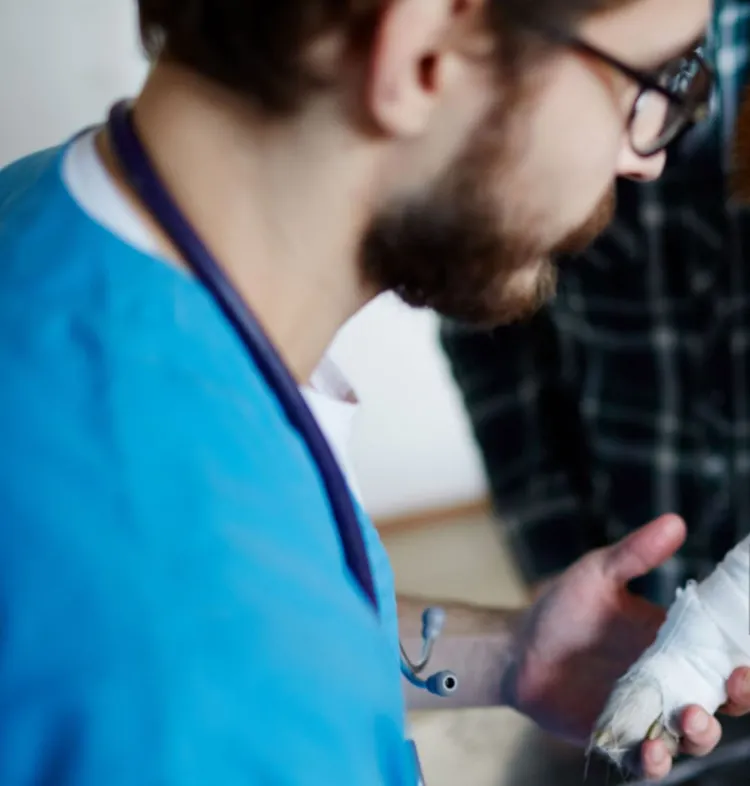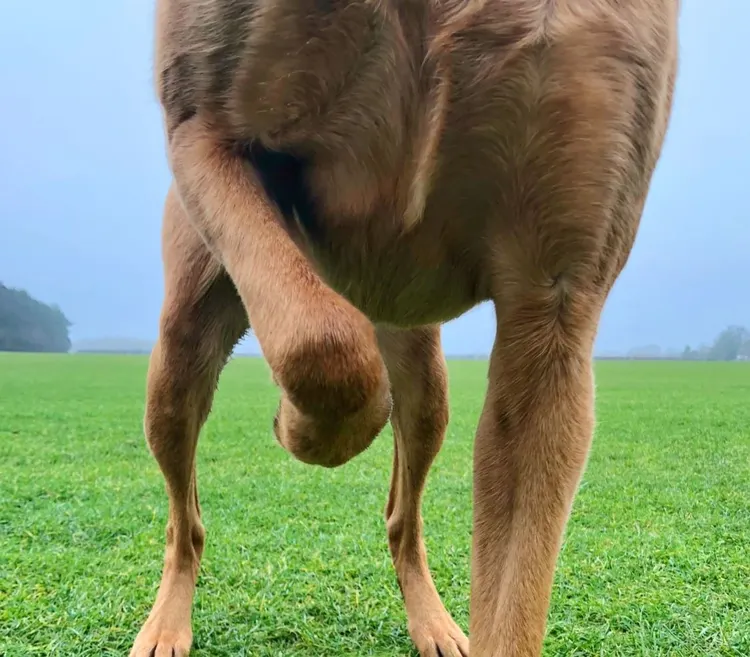It’s every pet owner’s worst nightmare—your dog suddenly yelps in pain, limps, or refuses to put weight on a leg. In moments like these, you might find yourself asking, “How do I know if my dog’s leg is broken?” While it’s normal to panic, staying calm and knowing how to identify the signs of a broken leg is essential to getting your furry friend the help they need. In this blog, we’ll cover the key symptoms of a broken leg in dogs, steps for first aid, and tips on preventing injuries through proactive care.
How to Identify a Broken Leg in a Dog
When a dog’s leg is fractured, there are often visible and behavioral signs that pet owners can spot. Let’s take a closer look at some of the telltale indicators of a broken leg in dogs.
1. Visible Symptoms
Physical signs can give you clues that your dog’s leg may be broken. Here are some things to look out for:
- Swelling or Bruising: A swollen or bruised leg is a common indicator of injury, particularly if your dog has been involved in a recent accident.
- Unnatural Angles or Deformities: If the leg appears to be at an odd angle or shows any deformity, this could suggest a fracture.
- Limping or Refusal to Bear Weight: If your dog avoids putting weight on the injured leg, it may be broken.
- Cuts or Open Wounds: Sometimes, a break may be accompanied by open wounds if the bone has punctured the skin, a condition known as a compound fracture.
2. Behavioral Signs
Beyond physical changes, dogs often exhibit behavioral changes when in pain. Keep an eye out for these warning signs:
- Vocalizing Pain: Dogs might yelp, whine, or cry, especially when the leg is touched or moved.
- Hesitation to Move: Dogs with a broken leg may refuse to move, even when called.
- Restlessness or Anxiety: Some dogs become visibly anxious or restless after sustaining an injury, pacing or panting more than usual.
3. Changes in Temperament
In addition to physical and behavioral signs, dogs in pain may undergo mood changes. If your dog shows sudden aggression, restlessness, or agitation, it could be a response to the discomfort caused by a fracture.
Immediate Steps if You Suspect a Broken Leg
Once you recognize the signs of a possible broken leg, it’s crucial to act quickly but calmly. Here are some immediate steps you can take to stabilize your dog before professional help is available.

1. Stay Calm and Keep Your Dog Calm
Dogs are highly sensitive to human emotions, and if you panic, they will likely become more stressed. Take a deep breath and remain calm, so you can approach your dog carefully and reduce their anxiety.
2. Immobilize the Leg
If your dog is in distress and the leg appears unstable, it’s important to immobilize the limb to prevent further injury. You can gently wrap the leg with a soft cloth, towel, or bandage, but avoid applying too much pressure. If you have a splint or a makeshift version, you can use it to support the leg further. Be cautious not to move the leg excessively.
3. Contact a Veterinarian Immediately
Call your veterinarian as soon as possible. If the injury is severe and you cannot transport your dog immediately, describe the symptoms and follow any advice they give for safe transportation. You may need to take your dog to an emergency clinic, especially if the fracture is open (bone exposed through the skin) or if your dog is in severe distress.
4. Do Not Give Medication Without Vet Approval
While you may be tempted to relieve your dog’s pain, never administer over-the-counter medications without consulting a veterinarian. Some human medications, like ibuprofen and acetaminophen, can be toxic to dogs.
What to Expect During Veterinary Treatment
Once you arrive at the veterinary clinic, your dog will receive a thorough examination to determine the extent of the injury. Here’s what you can expect:
1. X-rays and Diagnostics
X-rays are usually the first step in diagnosing a broken leg. The images will help the veterinarian understand the severity and location of the fracture. In some cases, additional imaging tests, such as ultrasounds or CT scans, may be necessary if there are concerns about soft tissue damage or internal injuries.
2. Splints, Casts, or Surgery
The course of treatment will depend on the type and severity of the break:
- Splints or Casts: For minor fractures, a splint or cast may be sufficient to immobilize the leg while it heals. Your vet will also prescribe pain medication and anti-inflammatories.
- Surgery: For more complex breaks or compound fractures, surgery may be required to insert pins, plates, or screws to stabilize the bone. Post-surgical care will involve pain management, wound care, and follow-up visits for healing checks.
3. Recovery Period
Regardless of the treatment route, a broken leg requires time to heal. Depending on the severity of the break, recovery can take anywhere from several weeks to a few months. During this time:
- Limit Activity: Keep your dog as immobile as possible to avoid further injury.
- Follow Medication Instructions: Administer any prescribed medication on schedule.
- Regular Vet Visits: Attend all follow-up appointments to monitor healing and adjust care as needed.
Tips for Preventing Leg Injuries in Dogs
While accidents happen, there are proactive steps you can take to minimize the risk of leg injuries in your dog. Here are some strategies to help keep your dog safe:

1. Moderate Exercise
Exercise is essential for a dog’s health, but it’s important to ensure that your dog is not overexerted. Overactivity can lead to accidents, especially in puppies whose bones are still developing or senior dogs who may suffer from arthritis or joint problems.
Safe Exercise Tips:
- Start Slowly: If your dog is new to exercise, start with short walks and gradually build up their endurance.
- Use Leashes in Busy Areas: Always keep your dog on a leash in unfamiliar or high-traffic areas to prevent accidents.
- Choose Safe Play Areas: Make sure your dog’s play area is free from sharp objects, uneven surfaces, or other hazards.
2. Safe Home Environment
Create a dog-friendly space in your home to reduce the risk of falls and injuries. Consider adding non-slip mats in areas with smooth flooring and gating off stairs if your dog is prone to accidents.
3. Proper Diet
Maintaining healthy bones is crucial for injury prevention. Ensure your dog’s diet includes the right nutrients to support bone and joint health, such as calcium, phosphorus, and vitamin D. For senior dogs or those with joint issues, you might consider adding glucosamine or chondroitin supplements to support joint function and reduce the risk of injury.
Humane Care Practices During Recovery
Caring for a dog with a broken leg requires patience, compassion, and attention to their emotional well-being. Here are some humane care practices to keep your dog comfortable during the healing process:
- Create a Quiet, Comfortable Space: Set up a cozy resting area where your dog can relax without disturbances. Make sure it’s free of stairs and slippery floors.
- Provide Emotional Support: Dogs may feel anxious or restless during recovery. Spend time comforting them and offer gentle petting to reduce stress.
- Monitor for Complications: Keep an eye on the injury site and watch for any signs of infection, such as swelling, redness, or discharge.
Conclusion
A broken leg can be a distressing situation for both you and your dog, but by staying calm, recognizing the symptoms, and seeking prompt veterinary care, you can ensure your pet receives the best possible treatment. With a proper diagnosis and recovery plan, most dogs will heal and return to their playful, happy selves.
Prevention is always better than cure, so take steps to protect your dog by providing safe exercise, creating a secure home environment, and supporting their bone health with a balanced diet. By being proactive, you can reduce the risk of injuries and ensure your dog stays safe and healthy.



